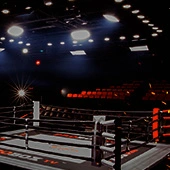It seems like only yesterday that I walked past the infamous pool at Caesar’s Palace en route to the outdoor arena. Built on tennis courts, the site served as ground zero for Marvelous Marvin Hagler versus Thomas Hearns – a fight so good that it was simply called “The Fight.”
Hagler-Hearns – held on Tax Day 1985 – was just the third fight in the history of CompuBox, with the first being Livingstone Bramble-Ray Mancini II at the Lawlor Events Center in Reno, Nevada two months earlier.
I’d been a serious boxing fan since May 24, 1968, the night Bob Foster won the world light heavyweight championship by icing my hero Dick Tiger with a single left hook in round four at Madison Square Garden. I witnessed that knockout on my Dad’s 12-inch black-and-white TV and I’ll never forget the suddenness and finality of that blow. One could fairly say that Foster’s hook caused me to become hooked on boxing.
Another important piece in my personal boxing history was seeing Muhammad Ali on “ABC’s Wide World of Sports” with Howard Cosell. I usually watched Ali’s fight standing up because I was too engrossed and stimulated to ever sit still for a 15-round fight. Then came the thrilling finals from the 1976 Olympics in Montreal where five Americans captured gold medals on the same telecast. Leo Randolph, Howard Davis Jr., Ray Leonard, Michael Spinks and Leon Spinks all reached the pinnacle of their amateur careers and captured the imaginations of the American public – as well as this Long Island teen-ager. That special night was joined by memories of watching Roberto Duran and Alexis Arguello blowing away challengers on many weekend afternoons – all on free over-the-air network television.
I attended several live shows at MSG, including Duran’s demolition of Davey Moore in June 1982. Ali also appeared at the fight, which produced perhaps the last great “Ah-lee! Ah-lee!” chant. I witnessed Hall of Famer Wilfredo “Bazooka” Gomez demolish the courageous but outclassed Nicky Perez in the Garden’s “Big Room” and I even made a trip to the Meadowlands in New Jersey to see late sub Ramon Ronquillo score a shocking KO over former light heavyweight champion Mike Rossman. These were all exciting memories for me, but nothing – and I mean nothing – could have prepared me for the excitement and exhilaration I experienced at ringside for Hagler-Hearns.
The converted tennis stadium looked innocent enough earlier in the day as the mid-April sun baked the wooden bleachers. By fight time – dusk in the desert – the place turned into a magical stage. A huge American flag – the largest in the world according to ring announcer Chuck Hull – was unfurled down the side of the Caesars Palace Fantasy Tower. Doc Severinson of “The Tonight Show with Johnny Carson” played the national anthem on his horn.
Then it was time to fight – and fight they did.
The experts thought the Marvelous One would box the dangerous Hearns in the early rounds. But as Bob Arum would say, “box, smox.” Hagler worked himself into a fighting froth by hitting himself several times before the first bell, then proceeded to charge straight into the cannon of Hearns’ right hand. What unfolded in those wondrous three minutes is almost beyond description, but most boxing historians would agree that the first round of Hagler-Hearns ranks among the most exciting, pulsating, high-octane rounds the sport has ever seen. Hagler and Hearns fought at a pace and with a ferocity that was only seen in the movies. Hagler and Hearns turn took inflicting incredible damage on the other and the crowd roared all the louder with every plot twist. Hagler hurt Hearns only to have the “Hit Man” strike back with a right that had Hagler’s crown teetering oh so briefly on his shaved skull. Soon a cut appeared on Hagler’s forehead, one that pumped blood at a frightful pace. The pair’s three minutes in fistic hell ended with a wild exchange along the ropes that served as a fitting crescendo to an unforgettable slice of sporting history.
I was counting Hagler on the CompuBox computer and I instantly knew that I had just witnessed one of the greatest rounds ever waged in a championship fight. Once the smoke cleared, Hagler had thrown 82 punches – all of them power shots – and landed 50. That power connect total remains the third most for middleweights in CompuBox history.
Let’s put that figure in further perspective: The CompuBox middleweight average for total punches thrown per round is 57, of which the typical 160-pounder lands 18. But in the first round of Hagler-Hearns, Marvin landed nearly as many power shots as the average middleweight throws! Hearns was no slouch either – in fact, the “Hit Man” threw more (56) and connected more times (56), but he mixed in 11 landed jabs into his offense.
I remember looking at the CompuBox action screen in disbelief as the round ended. Hagler’s jab column was a goose egg – zero in the round. Hagler, who went on to stop Hearns in the third, landed 96 of 173 overall (55 percent), including 90 power shots. For the record, Hearns went 94 of 166 (52 percent).
Several days later Hagler appeared on Johnny Carson’s “Tonight Show.” Johnny commented, “Marvin, you threw 82 punches in the round and landed 50 – no jabs. Man, you really meant business, didn’t you?” Marvin just grinned and shook his head “yes.” That moment – and that fight – would essentially serve as the birth of CompuBox, conceived at dusk in the Las Vegas desert and confirmed on late-night TV.
I came away from that experience asking myself a few questions: 1) We’re getting paid to do this? 2) Are all fights this exciting at ringside? 3) What could possibly top Hagler-Hearns?
Thirty-five years later I’m still asking that question.


